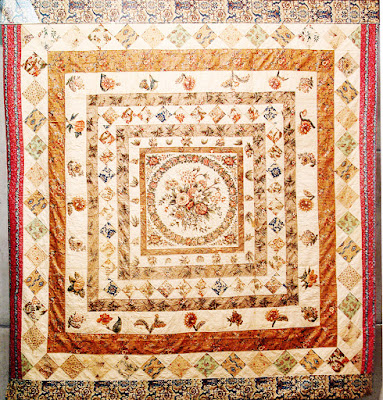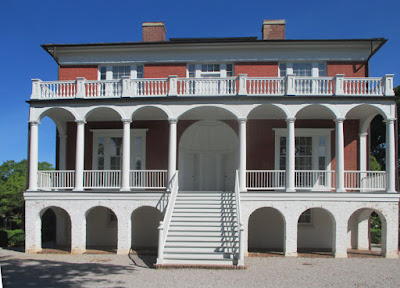"S.C. Chester District
Sarah M. Wallace
1829"
Collection of the Atlanta History Center
https://barbarabrackman.blogspot.com/2019/05/atlanta-history-center-4-jane-allen.html
Sarah Wallace's, dated a year later, features Panel #4, a round floral with a central bouquet. A white, six-petaled flower catches your eye.
Sarah's quilt was sold at auction a few years ago.
Perhaps made by Sarah Knox Wallace (1803-1901)
Interestingly enough, Sarah Knox Wallace's mother was named Jane Nesbit who married Hugh Knox of the Chester District (Districts in S.C. are like counties) in 1790. This Jane or Janet Nesbit Knox was born in Ireland in the 1760s (d. 1843) and is probably not the Jane Nesbitt whose name is on the quilt. But considering Southern naming patterns there were probably several related Jane Nesbitts in the family.
A third quilt is from the Wallace/Stevenson families of Richburg, Chester District, South Carolina, in the collection of the National Museum of American History, Smithsonian. Panel #5 is in the center.
But we digress. Back to Panel #4, which seems to have been printed in a second colorway.
Collection of the Metropolitan Museum of Art
Panel 4 in the center and #10 in the corners, all very tan.
They know little about its origins.
The Smithsonian has another quilt with Panel #4
Attributed to Annie Righton Smith, Gift of Patricia Smith Melton
We couldn't find any Annie Righton Smiths but the family may be that of Joseph and Elizabeth Fullerton Righton who had daughters Katherine Fullerton Righton Smith (1799-1843) and Ann Righton (1797-1857).
The Rightons lived in this house in Charleston, the Righton House.
And interestingly enough Katherine married a man named William
Wallace Smith, born in Scotland in 1793.
The Wallace connection.
We don't know much about this one in a private collection
but it certainly looks like a Carolina quilt.
We've two more quilts with panel #4, unlikely to
be related to any Wallaces in South Carolina.
This one is in Auckland, New Zealand in the Auckland War Museum where they have a typo in the date. It should read 1825-1850. It's attributed to Ireland.
https://www.aucklandmuseum.com/collections-research/collections/record/am_humanhistory-object-19159?class=Quilt%2C%20Bed&ordinal=8
And the last one: a very British looking with the frames of piecework giving a textured look with small scale prints and the black panels that are most common in the U.K.
What Have We Learned from Panel #4?
When we began looking at Southern chintz quilts and panel quilts in particular we looked for family connections, figuring that women who were related might have worked together to make similar quilts with the same fabrics.
1858 Portrait of a family
As we looked closer we realized family had very little relationship to style. Our conclusions now indicate that the chintz tops were probably purchased from workshops so women who didn't even know each other might have passed on similar quilts. However, quilts with this particular, rather unusual panel, may be an exception and knowing a family tree may help in determining the source of the fabric.
Panel #4 was not widely distributed in the United States: Six American quilts in the database. Perhaps some Wallace connection brought a few panels from England to the Carolinas as gifts.
































































